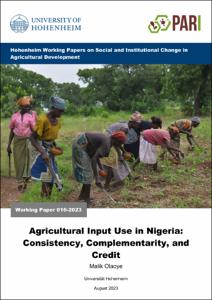Olaoye, Malik: Agricultural Input Use in Nigeria: Consistency, Complementarity, and Credit. Hohenheim: University of Hohenheim, 2023. In: Hohenheim Working Papers on Social and Institutional Change in Agricultural Development, 016-2023.
Online-Ausgabe in bonndoc: https://doi.org/10.48565/bonndoc-267
Online-Ausgabe in bonndoc: https://doi.org/10.48565/bonndoc-267
@techreport{handle:20.500.11811/11495,
doi: https://doi.org/10.48565/bonndoc-267,
author = {{Malik Olaoye}},
title = {Agricultural Input Use in Nigeria: Consistency, Complementarity, and Credit},
publisher = {University of Hohenheim},
year = 2023,
month = aug,
series = {Hohenheim Working Papers on Social and Institutional Change in Agricultural Development},
volume = 016-2023,
note = {There are complex synergies between different agricultural inputs and practices. For example, improved seeds reach maximum yields only in combination with fertiliser, and fertilisers may have limited effects without adequate weed control, which may necessitate the use of herbicides. Yet, agricultural inputs are often promoted to address single constraints of smallholder farmers without taking into account such agronomic synergies. In an earlier paper, Sheahan & Barrett (2017) found “a surprising dearth of synergistic use of modern inputs” in Africa, which they describe as an untapped potential. This study assesses input use in Nigeria using three waves (2010 – 2016) of the agricultural-focused household-level LSMS-ISA panel dataset (Living Standard Measurement Survey – Integrated Surveys on Agriculture) from the World Bank. The research explores whether Nigerian farmers use modern agricultural inputs, such as fertilisers, herbicides, pesticides, purchased seeds, and irrigation, synergistically or as stand-alone inputs. Additionally, the study investigates the consistency of input use, or whether farmers “move in” or “move out of” using some inputs, throughout 2010-2016. Lastly, the study analyses the effect of credit on using inputs individually and complementarily with logit and Poisson panel regression models. The study found that Nigerian farmers mostly use inputs individually, with fertilisers being the most utilized input. In the Northwest of Nigeria, about 70% of plots applied fertilisers, which was the highest share nationwide. Complementary use was low, with herbicides and fertilisers being the most jointly used inputs, accounting for 20% of plots on the national level. Consistency of input use ranged from moderate to low. Fertilisers and purchased seeds were used by 47% and 50% of households in at least two waves, while the consistency of other inputs’ use was lower. Credits were found to have varying impacts depending on the input and the administrative zones. The type of credit (formal or informal) also mattered for some inputs. Other factors affecting input use included the types of crops (cash crop or food crop), non-farm income, and extension services. Credit was found to be relevant for the complementary use of inputs in Nigeria, and the interaction terms of credit and extension were correlated with using inputs (including fertiliser). The study recommends that agricultural policies regarding credit and inputs should be considered on a zonal or local level rather than nationally. Furthermore, extension services promoting the benefits of using agricultural inputs complementarily should also be promoted.},
url = {https://hdl.handle.net/20.500.11811/11495}
}
doi: https://doi.org/10.48565/bonndoc-267,
author = {{Malik Olaoye}},
title = {Agricultural Input Use in Nigeria: Consistency, Complementarity, and Credit},
publisher = {University of Hohenheim},
year = 2023,
month = aug,
series = {Hohenheim Working Papers on Social and Institutional Change in Agricultural Development},
volume = 016-2023,
note = {There are complex synergies between different agricultural inputs and practices. For example, improved seeds reach maximum yields only in combination with fertiliser, and fertilisers may have limited effects without adequate weed control, which may necessitate the use of herbicides. Yet, agricultural inputs are often promoted to address single constraints of smallholder farmers without taking into account such agronomic synergies. In an earlier paper, Sheahan & Barrett (2017) found “a surprising dearth of synergistic use of modern inputs” in Africa, which they describe as an untapped potential. This study assesses input use in Nigeria using three waves (2010 – 2016) of the agricultural-focused household-level LSMS-ISA panel dataset (Living Standard Measurement Survey – Integrated Surveys on Agriculture) from the World Bank. The research explores whether Nigerian farmers use modern agricultural inputs, such as fertilisers, herbicides, pesticides, purchased seeds, and irrigation, synergistically or as stand-alone inputs. Additionally, the study investigates the consistency of input use, or whether farmers “move in” or “move out of” using some inputs, throughout 2010-2016. Lastly, the study analyses the effect of credit on using inputs individually and complementarily with logit and Poisson panel regression models. The study found that Nigerian farmers mostly use inputs individually, with fertilisers being the most utilized input. In the Northwest of Nigeria, about 70% of plots applied fertilisers, which was the highest share nationwide. Complementary use was low, with herbicides and fertilisers being the most jointly used inputs, accounting for 20% of plots on the national level. Consistency of input use ranged from moderate to low. Fertilisers and purchased seeds were used by 47% and 50% of households in at least two waves, while the consistency of other inputs’ use was lower. Credits were found to have varying impacts depending on the input and the administrative zones. The type of credit (formal or informal) also mattered for some inputs. Other factors affecting input use included the types of crops (cash crop or food crop), non-farm income, and extension services. Credit was found to be relevant for the complementary use of inputs in Nigeria, and the interaction terms of credit and extension were correlated with using inputs (including fertiliser). The study recommends that agricultural policies regarding credit and inputs should be considered on a zonal or local level rather than nationally. Furthermore, extension services promoting the benefits of using agricultural inputs complementarily should also be promoted.},
url = {https://hdl.handle.net/20.500.11811/11495}
}






